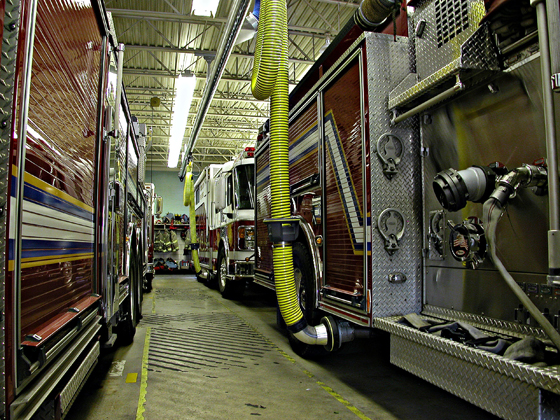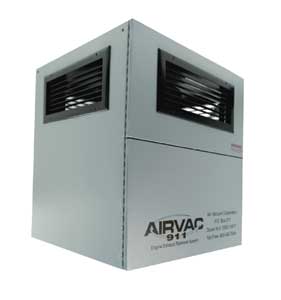
 |
| Click here to view the image gallery. |
By Chris Mc Loone
As firefighters, we know we will be exposed to products of combustion when we respond to working structure fires.
The personal protective equipment we wear protects us from these products of combustion, but we know we must regularly clean and sanitize our turnout gear to ensure we remove all traces of the carcinogens that are part of these products. We know that these carcinogens can enter our bodies through skin absorption if not removed from our gear. It’s the reason we shower as soon as possible after a structure fire. We don’t want any smoke residue on our bodies.
Exposure to smoke is an obvious cancer threat. Back at the station, where we often spend most of our time when on duty, there is another cancer threat that is easily controllable: diesel exhaust. There are various products on the market to help remove this known carcinogen from fire stations and, when it comes to firefighter health and safety, that are wise investments.
Health Issues
Diesel exhaust has long been suspected of being a human carcinogen, but in June 2012, the World Health Organization (WHO) classified it as carcinogenic to humans. “The National Fire Protection Association has said for the last 10 years that removal of exhaust in the fire station is important for the health and safety of firefighters,” says John Koris, regional sales manager, Air Vacuum Corporation. “But, probably the biggest change took place in 2012 when the WHO declared diesel a known carcinogen. Prior to that, it was listed as probable.”
Scott Beecher, president, Ward Diesel, adds that the International Agency for Research on Cancer has classified diesel exhaust (DE) and diesel particulate matter (DPM) as known human carcinogens (Group 1). “When diesel fire trucks idle inside the fire station, exhaust generated can spread throughout the entire station, where it can darken walls and settle on food and clothing,” he says. “Short-term exposure to high concentrations of DE/DPM can cause headaches, dizziness, and irritation of the eye, nose, and throat severe enough to distract or disable personnel. Prolonged DE/DPM exposure can increase the risk of cardiovascular, cardiopulmonary, or respiratory disease and lung and other cancers.”
Mike Johnson, vice president of sales, Clean Air Concepts/MagneGrip Group, says that effectively removing diesel exhaust fumes is something that no longer can be overlooked when designing a station. In addition to firefighter health and wellness, he says there are other reasons to address diesel exhaust at the station. “To maintain vehicle preparedness, firefighters often will test vehicles indoors, especially during inclement weather,” he says. “To meet the International Mechanical Code, a hose must be connected directly to the tailpipe when running vehicles indoors for maintenance and testing purposes.”
Removal Solutions
According to Beecher, there are three main types of solutions and advantages and disadvantages associated with each. “You have a hanging solution where a hose physically attaches to the tailpipe. Another system would be a ceiling-mounted system, and the third technology is vehicle-mounted.”
Beecher points out that newer diesel vehicles that use urea still need to be handled as producing dangerous emissions. There are new byproducts of the emissions, such as carbon monoxide and ammonia, that must be addressed.
All three solutions can be used in new and existing stations. “Each fire station is different in some way,” says Bryan Reeves, technical program manager, Plymovent Corp. “Therefore, the installation of the system will slightly vary.”
Johnson adds that although many new fire station projects include MagneGrip Systems, most of his company’s installations are done in older existing stations: “Installers are able to work around radiant heaters, light fixtures, sprinklers, and other obstacles to get a system properly installed.” Stations built prior to 2003, he adds, are eligible for grant funds through the Department of Homeland Security. “Although older stations are much smaller than today’s buildings, fitting a vehicle exhaust removal system into an existing building is still rarely a problem,” he says.
“You have two types of phases: new construction and retrofitting in existing stations,” says Koris. “With our system, you can place it basically anywhere. We have never had one that we couldn’t install. There’s a lot of flexibility.”
Vehicle-mounted systems allow for any configuration of vehicle parking and allow personnel to move vehicles from station to station as circumstances require. There are no building modifications necessary.
Source Capture SolutionS
Plymovent offers a pneumatic source capture system, a magnetic source capture system for vehicles with undercarriage exhaust pipes, as well as a vertical stack rail (VSR) system for exhaust removal from vehicles with overhead exhaust stacks. A Plymovent system also includes an exhaust fan, a control panel, and turnkey installation by a factory trained and certified contractor. “We offer a pneumatic system that incorporates an inflatable ‘grabber’ nozzle that inflates around any exhaust tailpipe, virtually removing 100 percent of the diesel exhaust from the running vehicle,” says Reeves. The system, when properly used, prevents any particulate or gases from escaping into the apparatus bay, he adds. “We also offer a magnetic source capture system that incorporates a magnetic grabber, which securely attaches to the exhaust tailpipe, essentially an extension of the tailpipe to the outdoors,” says Reeves. The VSR, he says, is the simplest system of all in that there is no hose or nozzle to hook up. “The vertical exhaust stack gets an adapter at the top, which allows the exhaust pipe to slide into the VSR rail where the exhaust is moved outside as the engine starts, and the exhaust fan is energized,” he says.
When a vehicle activates a system by starting, the fan is automatically energized, the vehicle begins to leave the system, and the grabber nozzle automatically releases from the tailpipe at or near the door threshold. The fan stays on for a predetermined period of time and turns off automatically. It turns on again when the vehicle comes back to the station when the nozzle is again attached to the tailpipe.
Clean Air Concepts/MagneGrip offers a variety of source capture systems that connect directly to the tailpipe. “These systems are automatic and activate an exhaust fan when the vehicle starts and will ventilate exhaust fumes directly from the tailpipe to the outside,” says Johnson. “A track or rail system will transport the hose from the at-rest position all the way to the door threshold, eliminating exhaust fumes within the building. The system will shut down after the vehicle leaves the bay area. Johnson says his company offers systems to meet the needs of every station, for example those with back-in, tandem, and drive-through configurations.
Filtration Solutions
Air Vacuum Corporation manufactures the AirVac 911 exhaust removal system, according to Koris, which was designed for fire departments and emergency medical services facilities. “Our system is a filtration system,” he says. “We remove both of the carcinogens-the gases as well as the particulate, which is another component of diesel exhaust. Our system does not require any personnel intervention to operate.”
Clean Air Concepts/MagneGrip Group also offers air filtration and purification systems. Although not a direct source capture system, says Johnson, AirHAWK air purification units are designed to rapidly filter particulate and many volatile organic components. “Air purification units can be used in conjunction with a hose drop system or on their own,” says Johnson. “AirHAWK units use a multiple stage process including high-efficiency particle filters, gas chamber filtration, UV-C lights, and a catalytic oxidation chamber.”
According to Koris, the only required maintenance for his company’s filtration system is periodic filter changes. “Anywhere from 12 months to 24 months, the department would have to change the filters in the unit,” he says. “That is the only maintenance they have.”
Vehicle-Mounted Solutions
Ward Diesel offers two vehicle-mounted solutions, NO SMOKE and NO SMOKE 2. “What we provide is an automatic solution that filters the emissions when you’re in the station, when you’re returning to the station, and when you’re on scene,” says Beecher. “The advantage of a vehicle-mounted solution is it goes with you and gives you on-scene protection.”
NO SMOKE is for vehicles with engines built prior to 2007 and is an apparatus-mounted, direct source capture system. It features a Corning DuraTrap™ CO diesel particulate filter that removes particulate matter from diesel exhaust. The filter consists of thousands of individual channels. Beecher says that 70 to 75 percent of Ward Diesel customers change out a filter once every two to four years.
NO SMOKE 2 is designed to meet the needs of engines built in 2007 and later. It features a substrate with proprietary wash coat that removes harmful gases from diesel exhaust. While exhaust flows down the substrate’s channels, the gases interact with a precious metal coating on the cell walls, turning dangerous exhaust gases into harmless carbon dioxide and water vapor.
NO SMOKE operates when an electronic control module engages a diverter unit, directing vehicle exhaust into the filter. The system has a timer to filter exhaust for a preset period, allowing time for the apparatus to leave the station. It automatically engages when the truck is put in reverse to back into the station and will continue to clean exhaust until the engine stops. A manual override keeps the system in filter mode while the engine idles, so no one at the scene of an incident has to breathe the exhaust. An operator can also engage the manual override for stations with pull-through features.
NO SMOKE 2 differs from NO SMOKE in that it does not require the diverter box technology. The system is constantly filtering.
Selection Advice
According to Koris, when selecting a diesel exhaust removal system, the main criteria to look at is a department’s requirements: apparatus, number of runs, and accessibility of the system. He adds that cost is naturally a factor as well. “Probably cost is one of the biggest considerations, he says. “Everybody knows from a health and safety standpoint that they should have something-even departments that don’t have something will agree with you. And, a lot of it comes down to cost.”
Beecher suggests not only looking at the product itself and what it does but also looking at the long-term costs and long-term benefits. He adds, “Talk to existing customers. You’re looking at a solution you want for many years, and it’s not just a widget you’re buying off the shelf. Talk to people who have been using those products for many years. Ask them the tough questions. They’re going to tell you what they like and what they don’t like. They’re going to give you the down and dirty on the product and the company that’s behind it.”
From a practical standpoint, Reeves says to begin by determining the most effective method of removing the exhaust from the firefighters’ and other employees’ breathing zones. “Selecting a system that effectively removes virtually all of the carcinogens from the apparatus bay is controlling the liability,” he says. “Any system short of that is contributing to the liability.”
“It has been our experience that firefighters are genuinely concerned about the effects of diesel exhaust fumes and are extremely appreciative when a system is installed in the workplace,” says Johnson. “The department should turn to a company that specializes in manufacturing and installing vehicle exhaust removal systems for the fire rescue industry.”
Most importantly, it is important to remember that controlling firefighters’ exposure to diesel exhaust at the station is not difficult. “While it is true that firefighters are exposed to many dangers on the job,” says Johnson, “diesel exhaust is one danger that is easily controlled.”
CHRIS Mc LOONE, senior editor of Fire Apparatus & Emergency Equipment, is a 21-year veteran of the fire service and an assistant chief with Weldon Fire Company (Glenside, PA). He is a member of apparatus and equipment purchasing committees. He has also held engineering officer positions, where he was responsible for apparatus maintenance and inspection. He has been a writer and editor for more than 20 years.

